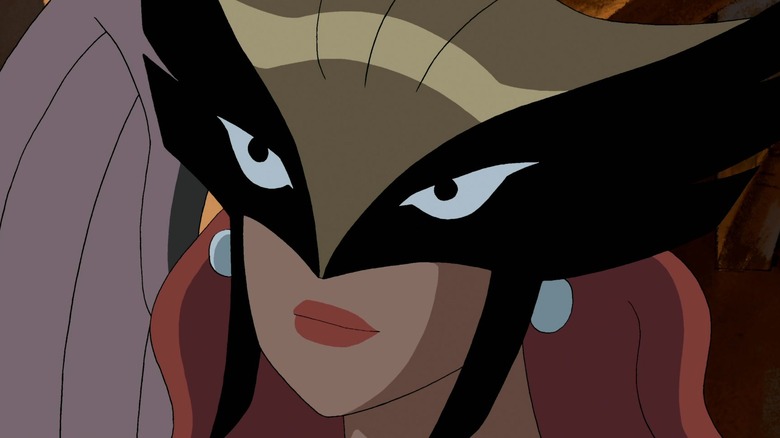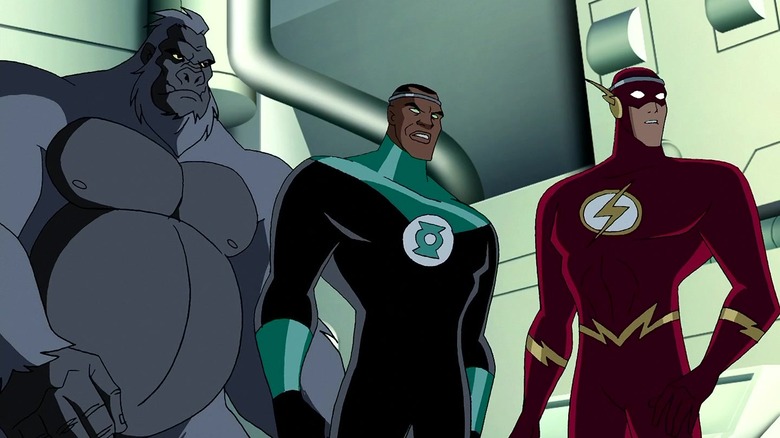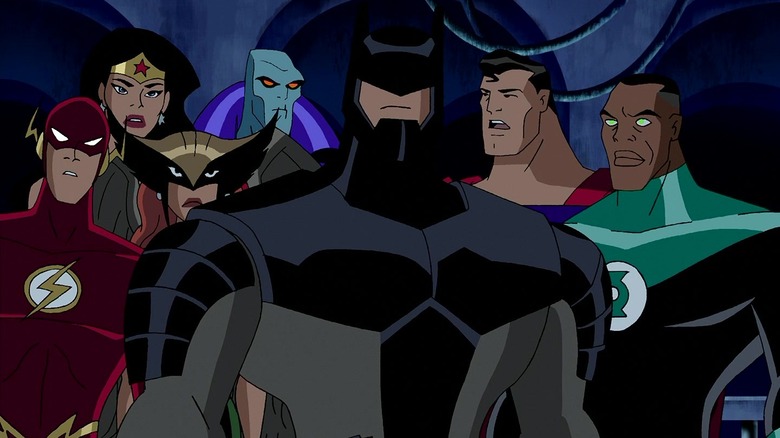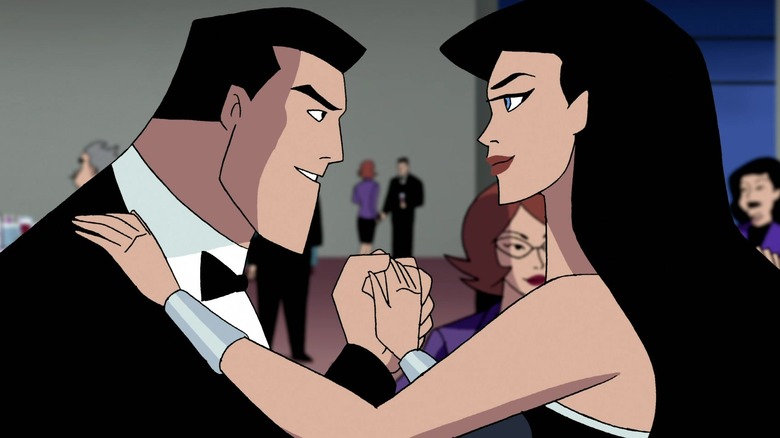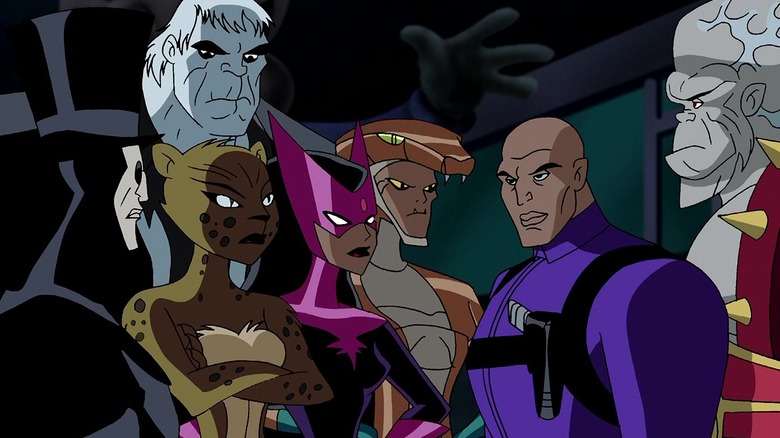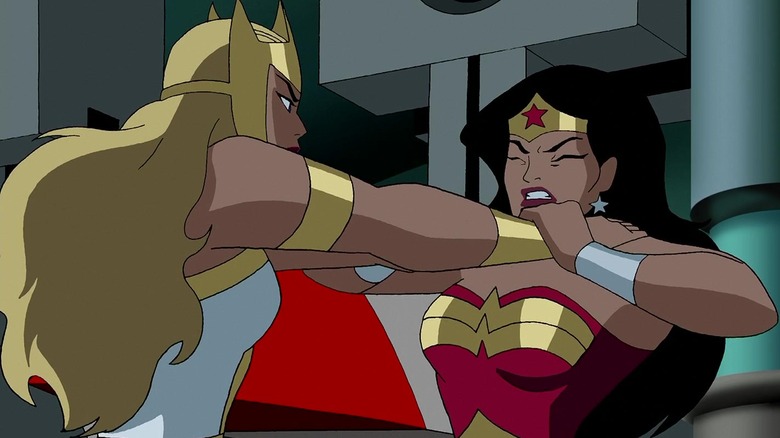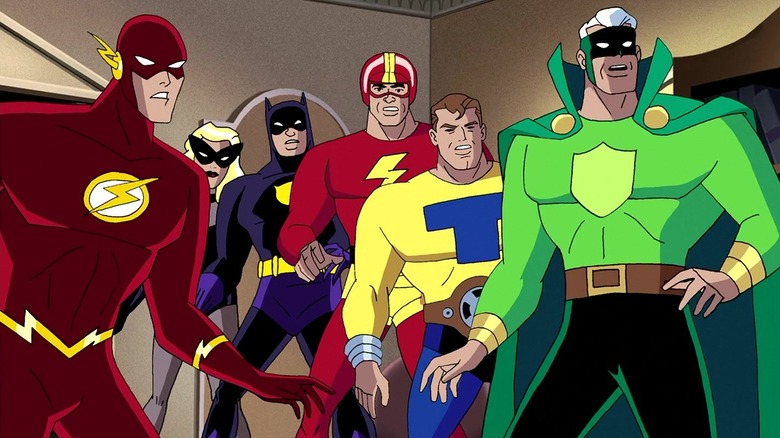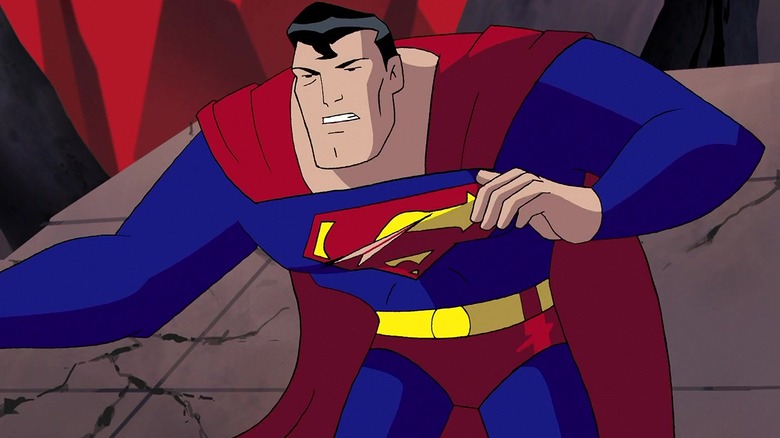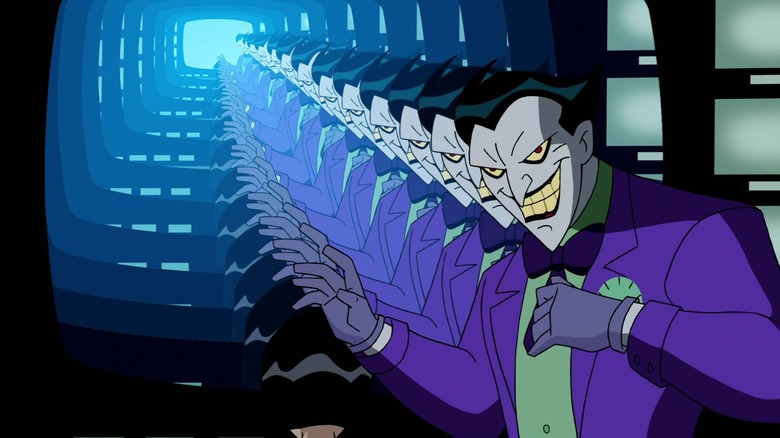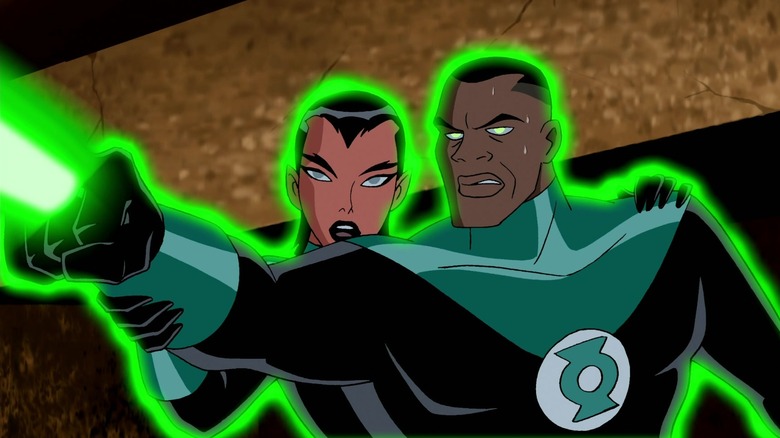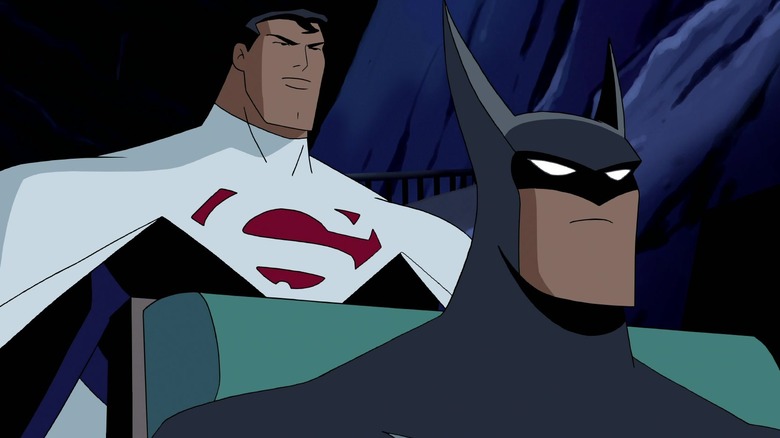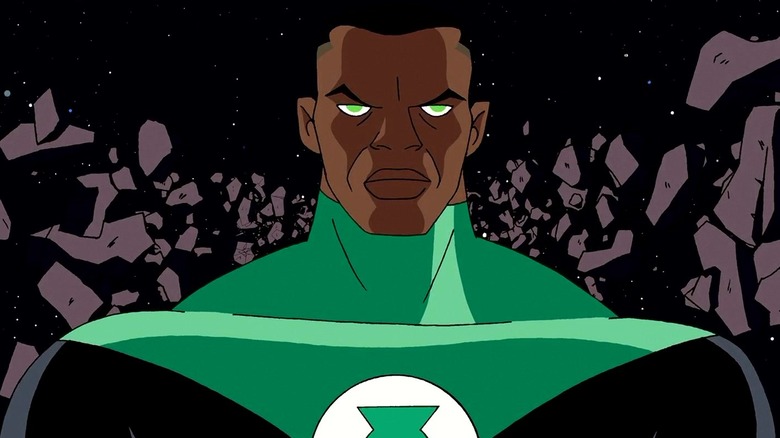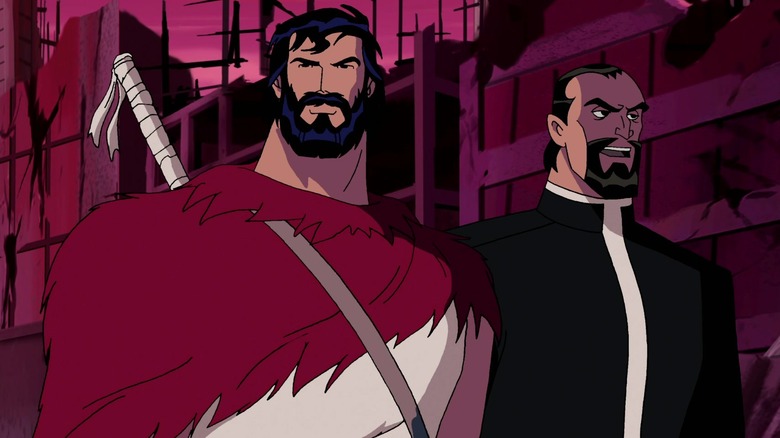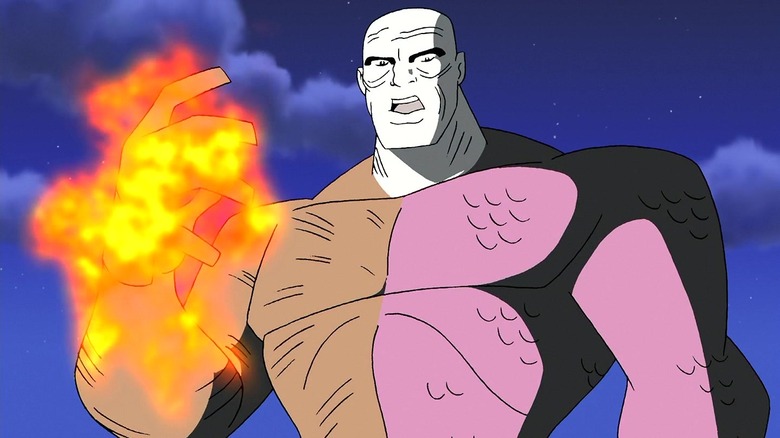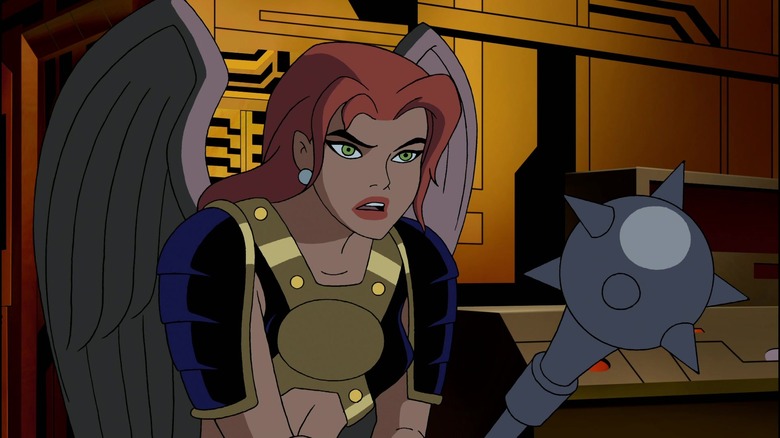The 7 Best And 7 Worst Episodes Of Justice League
"Justice League," which hit the airwaves in 2001, is one of the best superhero cartoons ever made. While a future version of the League had shown up in "Batman Beyond," no present-day version of the team had appeared in the DC Animated Universe before "Justice League" came along. This rendition of the iconic group promptly established itself as one of the best. Unlike "Justice League Unlimited," its similarly excellent sequel, "Justice League" features only seven heroes on the titular team. This smaller line-up allows each and every character to shine with unique brightness.
"Justice League" has a bit of a bumpy beginning — as series developer Bruce Timm revealed to World's Finest, the creative team was still figuring certain things out in Season 1. Yet the series soon finds itself, delivering a phenomenal Season 2 that ranks right up there with the DCAU's best. This prompts an intriguing pair of questions: Which episodes stand above the rest, and which sink to the bottom? Rather than decide ourselves, we let IMDb users do the ranking. Prep the Javelin-7 for launch and refuel the Flashmobile, because it's time to explore the seven best and seven worst "Justice League" episodes.
Worst: The Brave and the Bold (7.55)
No matter who's behind the scarlet cowl or power ring, Flashes and Green Lanterns have always gotten along ... but not always right away. "Justice League" honors this tradition with its Flash and Green Lantern, aka Wally West and John Stewart, in "The Brave and the Bold: Part I" and "The Brave and the Bold: Part II." Better yet, the show uses this team-up to introduce classic Flash foe Gorilla Grodd, the benevolent Solovar, and their home, Gorilla City.
"Justice League" has a lot of fun exploring how the Flash's laid-back, jokey attitude clashes with Green Lantern's no-nonsense demeanor. The two even literally fight each other when Grodd temporarily takes control of Wally's mind, further playing up the tension. While they don't become best buds by the end of these episodes, you can definitely see a friendship forming, as their put-downs become more comedic than genuine.
This isn't enough to dazzle IMDb viewers, unfortunately. "The Brave and the Bold" isn't bad — it's just not as impressive as the series' high points. Moreover, Gorilla City is a lot of fun, but it isn't one of the most beloved locations in DC Comics history. These episodes are first and foremost for Green Lantern and Flash die-hards, some feel, and that allegedly niche nature prevents them from landing higher on this list.
Best: The Savage Time (8.43)
You know an episode is important when the villain's name is in the title. Vandal Savage makes his entrance in "The Savage Time: Part I" and "The Savage Time: Part II," where he sends his past self the means to win World War II. After watching the world as they know it transform into a totalitarian regime, the Justice League must travel to 1944 — with a little help from a time-altered Batman — and set things right.
Seeing as DC Comics' heroes have existed for decades, a jaunt through history can mean only one thing: It's team-up time. Sadly, there's no Justice Society of America in the DC Animated Universe, but the League does get to hang out with the Blackhawks, and John Stewart proves he doesn't need a charged power ring to take the fight to Savage himself. Perhaps the biggest-profile hero to debut here, however, is Steve Trevor, longtime Wonder Woman supporting character and occasional love interest. Their reunion in the present day is one of the most touching moments in these episodes. Also, can we admire just how cool Savage Time Batman's costume is?
Worst: Maid of Honor (7.55)
Princess Audrey of Kasnia wants to spend the days leading up to her wedding in style. She convinces Wonder Woman to be her bodyguard — and clubbing companion — after the amazing Amazon saves her from being kidnapped. Sadly, the man she marries, Vandal Savage, promptly uses his new royal status to turn Kasnia's international space station into a world-threatening rail gun.
"Maid of Honor: Part I" and "Maid of Honor: Part II" form an exciting action thriller, complete with jets, technologically-enhanced villains, and a giant superweapon. At its core, however, it's about the unlikely friendship between Diana and Audrey, two princesses who couldn't be more different. As they learn from each other, Audrey gets a sobering lesson in not taking everything at face value, while Wonder Woman tries taking things a little more easily. Naturally, other Leaguers eventually get involved, especially Batman. He not only uncovers Savage's plan with Wonder Woman, he also meets Diana out of costume for the first time ... and discovers even he can't hide his secret identity from the wisdom of Athena.
Overall, "Maid of Honor" is great fun, and shows that even the "worst" episodes of "Justice League" are far from bad. Its greatest sin, at least in the eyes of certain fans, is that it's a tad bit scattershot — but honestly, even its distractions are entertaining. A surprising ethical debate between Green Lantern, Flash, and J'onn J'onnz might seem out of left field to some, but it's also utterly engaging.
Best: Injustice for All (8.50)
The gang's all here in "Injustice for All: Part I" and "Injustice for All: Part II" ... the Injustice Gang, that is. After discovering he has Kryptonite-induced blood poisoning, Lex Luthor decides to get back at the Justice League with some pretty notorious help. Yet he soon finds that leading his Injustice Gang presents all kinds of complications, including dealing with a traitor in the ranks and the unexpected arrival of the ever-unpredictable Joker.
It's the character interactions that really make "Injustice for All" sing. Clancy Brown's return as Lex Luthor and Mark Hamill's as the Joker are undoubtedly the biggest highlights; longtime DCAU fans will be happy to see the characters pick up right where they left off after their ill-fated team-up in one of the best episodes of "Superman: The Animated Series." Equally engrossing is Luthor's chemistry with the cultured Ultra-Humanite, a character who's always had a rather unusual connection to Lex in the comics.
Batman manages to bring out even more aspects of the villains' personalities by psychologically manipulating nearly every Injustice Gang member he comes across when they take him as hostage. Couple that with various Easter eggs (including a statue of DC's beloved Wonder Twins in the Injustice Gang's hideout) and the Joker's hilarious fighting style, and you've got a great episode that delights old and new DC fans alike.
Worst: Fury (7.45)
How do you stop Earth from being "Man's World"? As far as Aresia is concerned, the answer's simple: Take the men out of the equation. That's the premise of "Fury: Part I" and "Fury: Part II," which remix various versions of the comics character Fury (and add a dash of Donna Troy) to create Aresia, a villain who's essentially Wonder Woman's antithesis.
One can't help but wonder if "Fury" might have been written differently today, perhaps with a stronger emphasis on the very real sexism that drives Aresia to create an allergen capable of wiping out the entire male population. Her methods would have been opposed regardless, but dedicating more scenes to the behavior she's fighting to end could have made her a more sympathetic character. One also wonders if the episode might have been stronger if Wonder Woman, who's still new to "Man's World" and superhero life, might have been initially swayed by Aresia's arguments before ultimately rejecting her end goals.
Still, a lot of "Fury" works. Not only do Wonder Woman and Hawkgirl get to save the world on their own, this two-parter is loaded with inspiring scenes of female firefighters, EMTs, and soldiers saving lives and helping others. The strongest scene in the episode by far involves Wonder Woman's mother Queen Hippolyta realizing how her own prejudices have helped fuel Aresia's actions.
Best: Legends (8.55)
Of all the episodes of "Justice League" Season 1, few are more moving than "Legends: Part I" and "Legends: Part II." This adventure sees Green Lantern, Hawkgirl, Martian Manhunter, and the Flash meet the Justice Guild of America. While John is stunned to learn that the heroes he thought were fictional actually exist in an alternate universe, he and his fellow Leaguers soon realize that something much more nefarious hides underneath the Justice Guild's seemingly idyllic world.
This episode is a heartfelt love letter to the Justice Society of America, which the Justice Guild is based off of (as Rich Fogel confirmed to World's Finest). Specifically, the Justice Guild is inspired by the JSA-centric comics of the '30s and '40s, and these episodes aren't afraid to poke fun at some of their cheesier elements, as well as allude to the era's different social attitudes. Ultimately, however, "Legends" is about the Guild's underlying heroism, and how their earnestness — and, most notably, their selflessness — inspired John Stewart to become a superhero himself. The ending is enough to move one to tears, and really speaks to what the Justice League and the Justice Guild are truly about.
Worst: War World (7.45)
"War World: Part I" and "War World: Part II" see the Man of Steel become an unwilling participant in alien despot Mongul's gladiatorial games. J'onn J'onnz comes along for the ride, and seeks to free his friend while Hawkgirl and Green Lantern search for them both.
"War World" does a commendable job of making Mongul's personality distinct from that of the visually similar Darkseid. Here, the contest-loving tyrant is a hedonistic showman who neglects his people, rather than a cold monster who rules with an iron fist. The episodes' biggest triumph, however, is the visual reinvention of Superman's gladiatorial rival Draaga, whose armored design is far more menacing than his comic book appearance. Branding himself with Superman's "S" symbol is definitely more impactful than simply wearing the Man of Steel's costume.
Still, despite these episodes' many positive attributes — which also include some great Superman fights and early teasing of the eventual Hawkgirl-Green Lantern romance — "War World" doesn't quite live up to its potential. It may have been more intriguing to see all the Leaguers forced to fight one another in Mongul's games, as happens in the later DC Comics series "Dark Knights: Metal." How might Batman have fared if pitted against the Flash or Wonder Woman? This is one of those rare instances where "Justice League" might have benefited from straying further from its source material.
Best: Wild Cards (8.85)
Only the Joker would think to menace Las Vegas while holding a telethon. While the Clown Prince of Crime has already proven himself capable of taking on the Justice League, "Wild Cards: Part I" and "Wild Cards: Part II" show he can also handle DC's greatest super-team without the Injustice Gang's help. Here, the Joker recruits his crimefighting partner Harley Quinn and a new version of the Royal Flush Gang. Fans of the animated "Teen Titans" series may find them familiar — they share voice actors with Robin, Starfire, Beast Boy, and Cyborg.
"Wild Cards" is a game-changer for "Justice League." It wraps up Mark Hamill's incredible run as the DCAU's Joker with a jaw-droppingly psychedelic showdown between the Clown Prince of Crime, Batman, and Ace. The biggest developments of all, however, involve Hawkgirl and Green Lantern. Shayera finally reveals her face, and the two heroes enter into a romantic relationship.
Even without these key moments, there's still a lot to like about "Wild Cards." Arleen Sorkin's return as Harley Quinn is a welcome one, though it's sadly her only "Justice League" appearance. Furthermore, having the "Teen Titans" cast voice the Royal Flush Gang is a very cool stealth crossover between the two shows. Finally, it's just a really well-written episode from Stan Berkowitz and Dwayne McDuffie, who pen the Joker with sublime skill.
Worst: Hearts and Minds (7.40)
How did John Stewart become such a tough-as-nails Green Lantern? As it turns out, he had a pretty great teacher. "Hearts and Minds: Part I" and "Hearts and Minds: Part II" brings in Green Lantern Katma Tui from the comics, and pits John, Kilowog, and his closest Justice League friends against famed JLA villain Despero.
Katma Tui and John Stewart have a long romantic history in the comics. "Hearts and Minds" retains this, but also makes Katma John's former instructor. Steely Katma's interactions with the similarly strong-willed John are full of sparks, especially when Katma must retrain her old pupil after Despero tampers with his mind. These aren't the only fun character interactions at play either, as John's bond with Hawkgirl continues to deepen, and Flash and Kilowog's new friendship proves to be a hoot and a half. Also of note is the story's reinvention of Despero as a charismatically tyrannical head of a religious cult, voiced by the same man who did Cartoon Network's early "Justice League" promos, Keith David.
And yet, "Hearts and Minds" clocks in at just 7.40 on IMDb. Perhaps this is due to Despero's lack of appearances in any other episodes. This is for understandable reasons, but a bigger presence on the show just might have snagged him a higher ranking. Still, he and Katma both do their comic incarnations proud.
Best: A Better World (8.90)
Is there such a thing as going too far in the name of peace? That's the question "Justice League" asks in "A Better World: Part I" and "A Better World: Part II" when the team encounters the Justice Lords, doppelgängers from another universe who've ended crime at the expense of the Earth's freedom.
It's not just the premise that makes "A Better World" such a dynamite story, it's the way it's handled. Right from the get-go, things start off strong by having Superman kill Lex Luthor. "A Better World" doesn't even reveal that Supes and his teammates are actually the Justice Lords until midway through "Part I," making it seem as though the Justice League has resorted to totalitarian measures. "Part II" is arguably even stronger, as Batman debates his Justice Lord counterpart over their contrasting methods, while the other Leaguers pay an eventful visit to the Arkham Asylum of the Justice Lords' universe. And then there's that other Lex Luthor ...
In an era when authoritarian antiheroes were all the rage in comics, "A Better World" came across as extremely timely. It remains relevant today. One can't help but be reminded of "Action Comics" #775, a celebrated issue in which Superman goes up against a group of antiheroes even more extreme than the Justice Lords. What makes "A Better World" especially poignant, however, is that the Leaguers are fighting the people they might one day become.
Worst: In Blackest Night (7.40)
"In Blackest Night: Part I" and "In Blackest Night: Part II" place John Stewart on trial for accidentally destroying Ajuris 4 ... and he's pretty sure he's guilty. While several of his fellow Corps members have written him off, the Justice League isn't convinced John committed the crime. Their instincts soon uncover a con of massive proportions.
"In Blackest Night" draws from John's failure to save the planet Xanshi in the comic arc "Cosmic Odyssey," which he blames on his over-reliance on his ring. But in that story, a planet is destroyed, whereas Ajuris' destruction is a ruse devised by Kanjar-Ro and the Manhunters. The changes are certainly understandable: Making John's arrogance debatably responsible for a planet's destruction is a touch unheroic for an all-ages cartoon. Still, having Stewart harm an entire world would have allowed the series to introduce Fatality, a Xanshi native who is essentially John's arch-enemy in the main DC universe.
Despite this missed opportunity, there's a lot to like about "In Blackest Night." The Flash's "defense" of John, for example, is a riot, and Superman's deduction of John's innocence would make Batman proud. There are also many moments yanked straight from the comics, like the Manhunters shouting their menacing slogan and John's recitation of the Green Lantern oath, that'll give any DC fan chills. Sure, the episode's not perfect, but there's still enough goodness to make "In Blackest Night" worth a watch.
Best: Hereafter (8.95)
DC Comics explored a world without a Superman in 1992, when the character (temporarily) died saving Earth from the rampaging Doomsday. "Hereafter: Part I" and "Hereafter: Part II" use the same premise, but instead of Doomsday taking the Man of Steel's life, it's the Superman Revenge Squad. They don't really kill Superman either — instead, he becomes the literal Man of Tomorrow when he's sent forward in time, to an era where an old enemy is waiting for him.
Despite the story's differences (including the gutsy move of making the Toyman Superman's apparent killer), "Part I" keeps the core idea of "The Death of Superman" and "World Without a Superman" intact. Superman's funeral is genuinely moving, thanks to music from Kristopher Carter, beautiful speeches from J'onn J'onnz and Batman, and enough cameos to make "Superman: The Animated Series" fans wipe a tear or two away with their red capes. Meanwhile, "Part II" shows viewers a Superman they've rarely seen. Kal-El grows a beard, forges a sword, and rides a "chariot" pulled by mutant wolves while trying to survive on a barren future Earth lit by a red sun. Equally surprising is the foe he runs into: A repentant Vandal Savage who's perhaps had a bit too much alone time since Superman last saw him.
Worst: Metamorphosis (7.40)
Though he's not as well-known as the Justice League's other members, wisecracking Metamorpho the Element Man has long been a staple of the DC Universe, and is even a Leaguer himself in the comics. It's only natural he'd be introduced into the DCAU eventually, and "Metamorphosis: Part I" and "Metamorphosis: Part II" at the very least succeed at accomplishing that. But this story doesn't rank highly on IMDb, and one can easily guess why. Though he evolves, Rex Mason isn't the most likable character. He's also fooled with alarming ease by Simon Stagg, who clearly has it in for him. Furthermore, while Metamorpho does join the League in "Justice League Unlimited," nothing else of lasting import comes out of these episodes. Rex himself never gets another big moment in the spotlight.
Still, "Metamorphosis" isn't all bad. This story finds an easy way to bring in Rex by revealing he's John Stewart's old Marine Corps buddy. Their feelings regarding the very different paths their lives have taken are at the heart of things, which is a great decision. Furthermore, Metamorpho's shape-shifting powers are well-animated and reminiscent of Clayface's transformations in the classic "Batman: The Animated Series" episode "Feat of Clay." Add to that the extensive usage of real-world science in "Part II" and a scene hinting at the burgeoning Hawkgirl-Green Lantern romance, and you've got episodes that really aren't too shabby, even if they aren't as remarkable as other "Justice League" installments.
Best: Starcrossed (8.97)
The "Starcrossed" saga — encompassing "Starcrossed: Part I," "Starcrossed: Part II," and "Starcrossed: Part III" — closes out "Justice League" and sets up "Justice League Unlimited" in grandiose fashion. What seems to be a peaceful visit from Hawkgirl's people, the Thanagarians, turns into a full-on Earth invasion. Worse still, Hawkgirl reveals she's a spy for the Thanagarian military and engaged to the invading fleet's commander, Hro Talak, which significantly complicates her new relationship with Green Lantern.
Everything you could want in a "Justice League" finale is in "Starcrossed": incredible battles, status quo-changing events, and great character interaction. The quiet scenes, like when the Justice League members reveal their secret identities to each other (or rather, Batman does it for them), are just as impactful as the big moments, as when Batman flies the Watchtower itself into the Thanagarians' weapon. The main event, however, is the final battle between Shayera, John Stewart, and Hro Talak. Here, Shayera must finally choose between her loyalty to her people and her friendship with the League.
With plenty of action, heart, and even humor, "Starcrossed" rightfully earns its spot as the highest-ranking "Justice League" installment. It also contains the last DCAU performance of Efrem Zimbalist Jr. as Alfred Pennyworth, who gives Shayera the sort of strong, fatherly advice he's been giving Bruce Wayne for years. Moreover, the biggest development of the episode, Shayera's resignation from the League, is explored quite effectively in "Justice League Unlimited." A fan simply couldn't ask for more.
